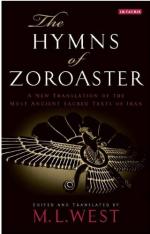|
This section contains 16,663 words (approx. 56 pages at 300 words per page) |

|
SOURCE: “Zoroaster's Own Contribution,” Journal of Near Eastern Studies, Vol. XXIII, No. 1, January, 1964, pp. 12-38.
In the essay below, Gershevitch investigates the nature of the discrepancies between the doctrines Zoroaster puts forth in the Gathas and those beliefs attributed to him in the Later Avesta.
I. the Three Versions of Zoroaster's Doctrine
Zoroaster's own verses, the Gathas, which may be dated to the first half of the sixth century b.c., form only a small part of the scripture that goes under the name of the Avesta. The difference between the doctrine which Zoroaster states or implies in the Gathas and the doctrine which is attributed to him in the remainder of the scripture has long attracted attention. To avoid confusion it is convenient to refer to the religion of the Gathas as “Zarathuštrianism” and to the doctrine of the Younger Avestan texts as “Zarathuštricism.” The...
|
This section contains 16,663 words (approx. 56 pages at 300 words per page) |

|


